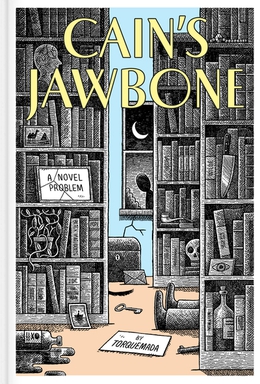
If you’re a fan of word games or TikTok, you may have heard of Cain’s Jawbone, the latest puzzling sensation to sweep the internet. Videos about the game have attracted millions of views and Gen-Z’ers all over have started covering their walls with sheets of paper like detectives in a murder mystery novel. But what is the puzzle, actually? If you’re not familiar, here are the Sparknotes.
History of the Cain’s Jawbone
Cain’s Jawbone is a puzzle book that was created by a man named Edward Powys Mathers way back in the 1930s. It’s a very unique puzzle: it consists of a hundred-page murder mystery novel that’s filled with fun puns and word games. As they read, the reader attempts to discover who the victims, murderer, and murder method are. The twist: a hundred pages are delivered out of order, meaning a puzzler has to arrange the pages properly to solve the mystery.
If you think this puzzle sounds easy, think again. The pages are deliberately designed to be difficult to properly arrange, with most of them ending in full stops (meaning you can’t simply connect pages by searching for sentence fragments to connect). Identifying information about the characters is rarely given, with even the gender of the narrator remaining unclear. And dates, also, are scarcely listed.
Since the puzzle was first released in 1934, only three known people have ever successfully solved it. Two of these solvers found the solution in the 1930s when the puzzle was first released; they were awarded a cash prize of £25 by the publisher. Another successful solver came more recently, in 2019, when the publisher re-released the book and offered a prize of a thousand bucks to anyone who could come up with the correct solution. Twelve different people submitted what they thought was the right answer, but only one, John Finnemore, was correct.
So what makes this puzzle so difficult? Partly, the many different types of word games and hints it contains. Clues are hidden in the text in the form of references, Spoonerisms, and quotations. These references make the game difficult now, but it was even more baffling in the 1930s before readers could Google the references hidden in the text. Moreover, it isn’t easy to know when you’ve reached the correct solution. Many puzzlers have come to what they think is the right answer, only to turn in their responses and be told they’re wrong.
Popularity Surge on TikTok
The re-release of the puzzle in 2019 won some new fans, but it wasn’t until 2021 that the puzzle took off online. That was when TikToker Sarah Scannell shared her own effort to solve the puzzle on the app. Scannell – who is far from an avid player of word games – saw Cain’s Jawbone in her local bookstore. Intrigued by the premise, she grabbed a copy. Soon, she found herself hooked. In her first TikTok on the puzzle, she shared that she had always wanted to turn her bedroom wall into a “murder board.” Cain’s Jawbone was the perfect opportunity.
The first step she took was to cut out each page of the book – which are conveniently single-sided, so they can be pasted to a wall or board – and hung them up alongside color-coded stickies and string. The effort immediately caught on, with Scannell’s first TikTok on the issue going viral and attracting over 1.4 million likes.
Since Scannell’s first TikTok, other online content creators have similarly jumped on the Cain’s Jawbone train. Several other TikTokers have documented their own efforts to join the elite pantheon of successful solvers. And Youtubers like Jack Edwards have started video series about the puzzle.
Efforts to Solve Cain’s Jawbone
Some people have chosen to collaborate on their murder walls. But others are taking a more individualistic approach. Considering the answer has not been given away in the last 88 years since it was first solved, it’s clear there’s a code of silence that surrounds the puzzle and continues to be maintained amongst aspiring solvers.
Strategies and tips to Solve Cain’s Jawbone
However, some online creators have given hints as to how they are going about solving the puzzle. Here are a few different approaches they’ve taken:
- Matching up fragmented sentences.
Most of the puzzles’ pages end on a hard stop: that is, they end with the end of a sentence. However, there are some pages that end halfway through a sentence. These pages are some of the easiest to link up with their partners because you can find a page that starts with the supplementary sentence fragment.
- Matching up quotations.
Similar to matching up fragmented sentences, matching up quotations is one of the most obvious ways to pair up sequential pages. While most pages do end with full sentences, there are several pages that end halfway through a quoted poem. For these pages, one merely has to Google the poem and find the next line. Then, find the page that starts with that line. This sounds simple, but keep in mind that it would have been a real endeavor back in the 1930s, before the existence of Google. One would have to be incredibly well-read and have a great memory to match up these pages appropriately. So for these types of hints, modern solvers have a real edge.
- Searching for dates.
The pages in Cain’s Jawbone aren’t dated – that would be too simple. But occasionally, the narrative references dates or holidays that can help arrange pages in a rough order. Unfortunately, this only applies to a handful of pages within the 100-page book.
- Looking for Biblical and other references.
While modern solvers may have the advantage of Google, they also have some disadvantages compared to the solvers in the 1930s, including cultural barriers. Many of the references in Cain’s Jawbone, which would have once been considered obvious, are now opaque to many people. For instance, there are many Bible references embedded in the story, including the titular Cain’s Jawbone, which refers to the murder weapon in the story of Cain and Abel. While in the 1930s, most Americans could be expected to pick up on Bible references, nowadays, the average American is less likely to be Christian, or at least devoutly so. That means there could be many references hidden in the text that your average reader won’t pick up on at all – something, that is, they won’t even know to Google!
On top of that, there’s also a language barrier at play. Several phrases and idioms have changed meaning over the years, confusing modern puzzlers. For example, several pages use terms like “gay” and “make love.” Those terms had completely different meanings in the 1930s as compared to now. Collectively, these challenges make it unclear whether modern puzzlers will see more or less success than their 1930 counterparts.
How You Can Solve Cain’s Jawbone
Unfortunately, since Scannell’s TikToks went viral, Cain’s Jawbone has been sold out in bookstores across the country. You could give your local store a try in the hopes that they still have a 2019 copy. However, the book’s publisher, Unbound Books, has seen its popularity online and is releasing a new run of 80,000 books soon. So keep an eye out for that release if you’d like to create your own murder wall!


